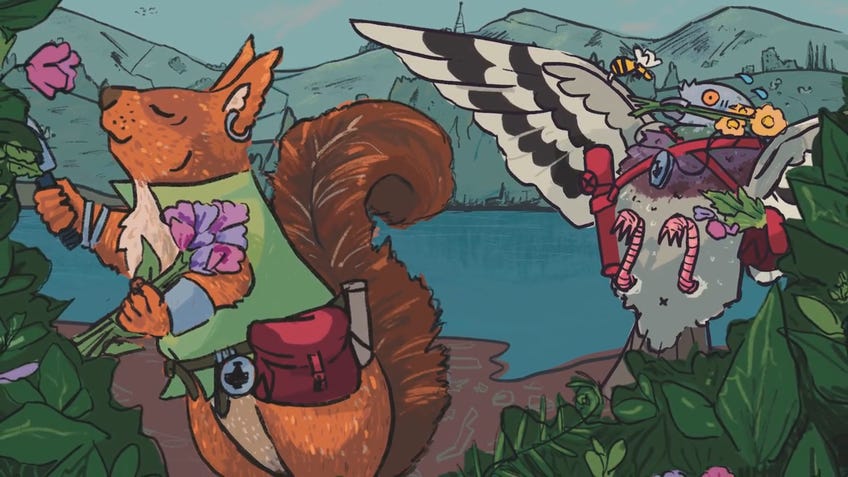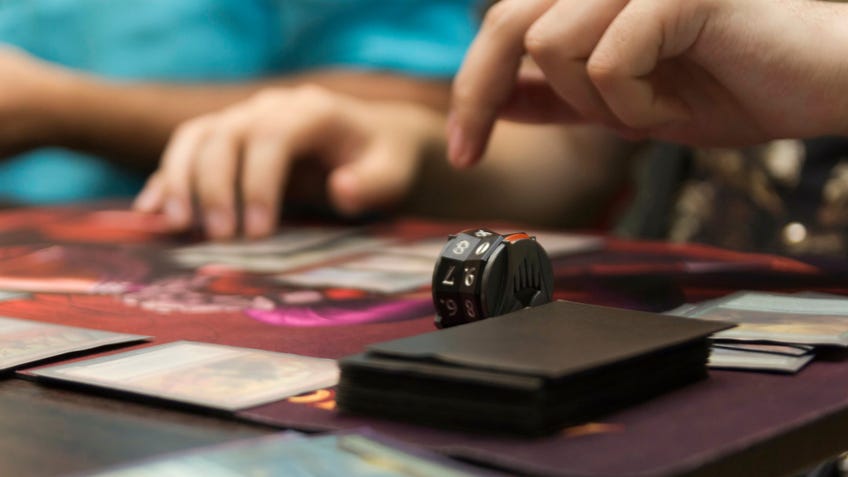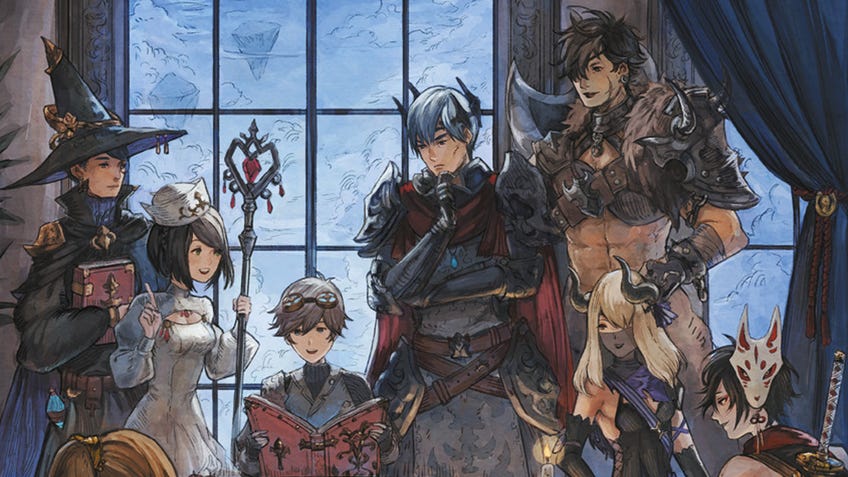What are you playing this weekend? Here’s what we’ve been playing!
Painting, apawthecary and more!
Welcome back, it’s Friday once again! That means the return of our weekly feature where you get to hear about all the games we’ve been playing lately.
As is always the way with these articles, these games might be things you’ve seen us play or discuss elsewhere on the Dicebreaker website and YouTube channel, or they might be things we haven’t found room to talk about just yet. They could be great, bad or anything in-between - the thing that connects them all is we reckon they’re worth highlighting!
This week, I’ve been venturing into the JRPG-inspired Fabula Ultima, Maddie’s been curing critters with potions in the Scottish Highlands, Meehan’s been painting the roses of Wonderland and Wheels is still playing Commander in Magic: The Gathering.
Read on for our thoughts, and be sure to share some of your own in the comments - we love hearing what you’re playing, or even what you’re hoping to play soon if you haven’t quite got it to the table yet. Whatever you’re playing, enjoy your weekend!
What We’ve Been Playing - June 8th 2023
Paint the Roses

Paint the Roses is an interesting kind of co-op board game. Set in the world of Alice in Wonderland, it’s a game wherein players must flee the wrath of the Queen of Hearts as they desperately carry out her orders to paint the white roses red.
This fiction translates into gameplay through players attempting to correctly guess what’s on their allies’ facedown cards, which will enable their shared piece to move along a track and away from the Queen. Players will need to choose a card from three available decks, each one offering a different level of challenge. Whilst the easy will only require players to correctly guess a combination of rose colours, the medium can feature colours or shapes and the hard can feature colours, shapes or a combination of both. However, the higher difficulty cards will move the players’ piece further along the track if guessed correctly, thereby moving them further from the Queen.
Once players have their cards, they will take it in turns laying down a tile on the board before selecting a card to be guessed. What kinds of tiles players will be able to lay will depend on what is currently available in the greenhouse, with the stacks of tiles containing a variety of shapes and rose colours. The goal of placing tiles should be to provide the other players with clues as to what is on their secret card. Players will lay down cubes matching their colour on a newly-placed tile if it makes the same combination as the one shown on their card, when it’s combined with any adjacent tiles. For example, if a player’s card depicts two red roses and they place a tile with a red rose on the board, if an adjacent tile also contains a red rose then a cube matching their player colour will be placed there.
What’s more, is that any of the other players will be able to place cubes on the newly-placed tile if - when combined with an adjacent tile - it makes the combination shown on their card, not just the active player. The active player will need to then select a card, which can be their own or another’s, to be guessed by another player.
The number and colour of cubes on the tiles placed by players should give the guesser clues as to what is on the other cards. Whichever players whose cards aren’t being guessed can then work together, through a process of elimination, as to what the secret combination could be. There’s even a chart for each player that the guessers can use to cross out combinations they think it couldn’t be. Obviously, as the players choose harder cards, they’ll need to think more carefully about where to place their tiles, whilst the others will need to consider even more potential combinations. This gets even more complicated once the available spaces on the board fill up and the options are limited.
Should players get it right, then their piece will be moved along the track equal to an amount shown on the guessed card. However, wrong guesses result in the Queen’s piece being moved forward. As players progress along the track, the number of spaces the Queen moves will increase, thereby racking up the tension and forcing players to balance the risk/reward of taking more challenging cards.
Though it all sounds very complicated, Paint the Roses is actually a really fun game to sink your teeth into. It’s the kind of puzzle game that gets easier to understand the more you play and makes you feel like a damned genius whenever you succeed. It takes a lot for me to be into a board game about logical puzzles, but Paint the Roses absolutely knocks it out of the park.
Meehan
Apawthecaria

Ever since I first got into solo journalling games, designer Anna Blackwell has been on my radar as someone to watch. Her witchy journalling game Apothecaria was one of my first introductions to the genre and helped me fall in love with the idea of a solo RPG.
There is a whole catalogue of great games over on their website, but the latest one to catch my eye is Apawthecaria, which takes the act of foraging for ingredients, brewing potions and helping cure ailments of those you meet to an expanded game with added cute animals. You play as a travelling Poltive Pounder, someone who seeks out those in need and helps them across your journeys on the Scottish Highlands - and you’re a cute critter, so that instantly makes it more adorable and therefore better.
You explore the world, heading to cities to barter, into the wilds to forage and into villages and settlements to meet beasts and help them. It’s a wonderful mix of creativity and mechanics. You pull cards to inspire situations at every point of your journey, from encounters with a deadly pike to identifying mushrooms for other foragers. Each outcome then has an effect on your game, gaining you reputation or losing foraging points and wasting time as an ailment's effects tick on.
Then you get into actually finding items; each has a specific location, seasons, rarities and preparation methods to use them in your cures. Then you need to collect and upgrade tools to cook or crush, brew or grind your finds, each creating different ways the ingredients can be used. That’s not even starting on the Barrows to explore, the apprentices to work with or guilds to help.
There’s lovely depth to what seems like a cute way to spend an afternoon at first glance. You really feel like you’re searching for these plants and crafting them into something special through all the work you do. I’m starting to think I could update my CV with all the knowledge I have now, but maybe curing Snail Ails isn’t transferable.
Maddie
Fabula Ultima

Fabula Ultima is a self-professed ‘TTJRPG’, heavily indebted to Japanese RPG video games like Final Fantasy - to which the name cheekily nods - as well as the two-dice system of pastoral Japanese tabletop RPG Ryuutama. Obviously, I was in love from the moment I saw it.
This is more than just a D&D reskinned to satiate JRPG fans. Italian designer-illustrator Emanuele Galletto’s clear appreciation of JRPGs is clear in Faula Ultima’s carefully constructed artwork, atmosphere and gameplay, which draws deeply from the turn-based combat of Final Fantasy and other classic video games without feeling like a cheap cash-in.
The game’s rules are kept beautifully light, with a mere handful of simple character stats - dexterity, insight, might and willpower - represented by scaling dice types - d6, d8, d10, d12 - that combine whenever a character faces a test. For example, dexterity and might might resolve a more physical challenge, while willpower and insight could come together during a dialogue check.
The same basic but versatile system (which will be familiar to Ryuutama fans) is used in combat, with players rolling two dice based on their weapon to judge its accuracy. If they land hit, the higher die determines damage. It’s a slick, quick system designed to keep combat flowing smoothly, and combines with a flexible initiative system that alternates turns between players and enemies - but without a fixed order - to capture the feel of a turn-based RPG without being too rigid or exhausting on the tabletop.
The character-driven stories of JRPGs are encouraged by a bonds system that provides ties between characters based on a set of broad relationships - admiration, loyalty, inferiority, hatred - and can be used to influence the outcome of tests by drawing on their emotions, spending fabula points earned by fumbled rolls and narrative progression. The same pool of points can be used to draw on the character’s inner nature and re-roll according to one of their defining traits, be it their identity, background or theme (a guiding mindset such as guilt or hope).
Fabula Ultima’s free Press Start scenario - which eases you into the RPG with pre-made characters and a step-by-step introduction to mechanics - gives a good taste of what to expect, with its similarly free Load Game booklet providing a leaping-off point for your own campaigns.
Having been through the beginner material and picked up the full rulebook at UK Games Expo last week (thanks to Meehan!), I am hugely excited to delve deeper into Fabula Ultima’s irresistible combination of tabletop roleplaying and JRPGs. As someone whose Final Fantasy playtime totals in the literal thousands of hours (and has a black mage tattooed on my arm), I can see myself losing a lot of time in this impressively realised tabletop tribute.
Matt
Magic: The Gathering

You’ll NEVER guess what I’ve been playing this week. Yes, I’m still obsessed with Magic: The Gathering and I’ve been back to another weekly Commander night at my friendly local game store. What I wanted to talk about more though is the new deck-building project I’ve set for myself.
With an unhealthy obsession for putting together new Commander decks (there’s just so many cool legendary creatures to build around!) I wanted to create for myself a long term project to build around; something to aim for not just in solitary decks to use at game nights, but a larger, idealised vision.
If you read my last little snippet on MTG in our weekly What We’ve Been Playing articles you’ll know that I’ve been really fascinated with the Star variant for Commander. Five players sit in a circle and have to defeat the players opposite them to win, with only the first one to do so taking the crown. It’s a fun way of speeding up five-player games - which can sometimes be a slog with that many turns to wait in between your goes.
But the ultimate form of Star requires mono-coloured decks. One of each colour, all placed in the way they would be on the back of every Magic card in their famous colour pie. Defeat your philosophical enemies to win! Only problem is, most people do not play mono decks in Commander. Limiting yourself to just one colour of magic can have you falling behind fast.
So my challenge? Say screw that and build a powerful deck of every colour regardless. My mono-Red Magda treasure deck is already forcing turn-five rage quits on Arena, I’ve got a Syr Konrad reanimator deck that’s really fun to play and I’ve just put together a mono-Blue, card draw-focused deck built around Jin-Gitaxias from the new March of the Machine set.
When all is said and done I’ll have the perfect game of Star just waiting for me whenever I want it. Now I just need to tackle my original favourite colour, White (I’m thinking a token spam deck built around Mondrak, Glory Dominus) and finally build a mono-Green deck which I’ve literally never done! Got any suggestions on what commander I should use? Let me know in the comments.
Wheels




